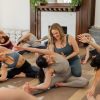
Lindsay Monal has crafted endless yin yoga classes, but one thing she’s been adding as of late has been a full 20 minute sound bath at the end of most of her yin classes. She has found that the deep, intensive stretching required for yin yoga poses coupled with a healing sound bath has been the perfect ethereal combination, leaving people feeling completely blissed out.
Below is a yin yoga class sequence perfect for ironing out the lower back and easing tension in the back. If you are a sound healer or sound practitioner, feel free to extend this class by 15-20 minutes to add a sound bath at the end of it!
Yin Yoga Poses
1. Constructive Rest
Keep your hands resting on your body, with the soles of your feet planted on the mat, mat-widths distance apart and let your knees knock in toward one another. Tuck your chin towards your body and allow yourself to arrive here in this practice.
2. Banana Bend (Both Sides)
Lie flat on your back, legs out long in front of you. Begin to arch your body to the side, making a banana shape. You can grab your top wrist (the one from the side that’s arching) with your bottom wrist (the side you’re leaning towards) for an extra stretch/extension. Do both sides.
3. Deer Pose
Sit on your mat with one knee bent back behind you and the other bent in front of that knee (letting the foot of the leg that’s in front gently graze the knee of the leg that is bent behind you). Don’t forget to do both sides, switching which knee goes in front!
Variations:
- Option to walk out onto forearms: You can lean forward, coming down onto your forearms.
- Option to place forearms on blocks: Place two blocks on the medium height setting in front of you. Lean forward, bringing your forearms down onto the blocks.
- Option to create a Stonehenge shape with two blocks and a bolster: Place two blocks on the medium height setting with a bolster lying across both of them (like a little bench for your head and/or arms. Lean forward, let your head and neck relax.
4. Supported Backbend (with Rolled Blanket)
Take your blanket off the stack, then roll it up along the longer edge (fringes facing out). Place the blanket at the back of your mat. Come to sit at the edge of the bottom of the rolled blanket, letting your tailbone be right up against the blanket. Slowly roll down onto the blanket, letting the entire length of the spine come down along the blanket. The blanket will be in between your shoulder blades, running down the entire length of your spine.
Variations
- Option to send legs out straight in front of you: If there is no pain/tension, feel free to send your legs out long in front of you.
5. Supine Twists
Lie on your back, bend your knees and let them fall over to the right. Let your shoulders lay heavily on the mat, gaze over your left shoulder. Bring your knees and head back to a neutral position and then let your knees fall over to the left as your gaze settles over your right shoulder. Try to keep your shoulders down on the mat, if there’s a bit of space, you can tuck a blanket underneath for support.
6. Savasana (with Bolster Under Knees)
To protect the lower back, a bolster is recommended for under the knees in savasana. This is usually the point in class where students are allowed to fully surrender and encapsulate all their efforts from the above poses. Guide them to tuck their shoulder blades under them to keep the chest open, tuck the chin a little towards the chest to keep the spine long, and send the legs and arms out long in front of them.
Incorporating a Sound Bath
If you’re going to incorporate a sound bath at the end, this is the perfect opportunity to do so – while students are in savasana. If you’re skilled with playing the bowls, you can have them set up before the start of class so as not to disturb anyone. Once students are fully lying down in savasana, start playing… building sound and variations of sound waves as they lie there.
Lindsay usually incorporates chimes, a singing frog, and any other instruments lying around the studio that feel like a good vibe for class that day. Feel free to have as much fun as you can with the diversity of sounds. Your students will love it!
In the above yin yoga class, Lindsay Monal guides Shelly Xu through the yin yoga sequence from this blog, guaranteed to help ease tension in the back. So, if you’re having any sort of mild back pain, this is the perfect yin practice for you! Give it a try…







